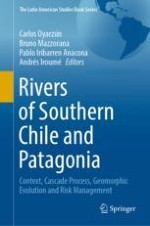This book provides a comprehensive analysis of the evolution of rivers affected by natural and anthropogenic disturbances in the southern Chile and Patagonia. It presents a detailed description of the rivers affected by climatic extremes, volcanic eruptions, large-wood dynamics and impacts, sediment-laden flows, and Glacier Lake Outburst Floods (GLOFs). Moreover, it contains an in-depth discussion of a variety of topics encompassing the ecosystem function of Pacific Patagonia rivers, the geomorphic signatures of Glacier Lake Outburst Floods (GLOFs) and their impacts within river corridors, as well as the assessment of the associated natural hazards and risks. Further, it provides proposals for public and territorial policies that improve the management and sustainable strategies of the hazards and risks.
This book is conceived by leading researchers of the Universidad Austral de Chile and includes contributions by distinguished scholars from around the world. It attracts a wide range of readers, including scientific community, researchers, undergraduate and graduate students, and policy makers from Chile and abroad.
